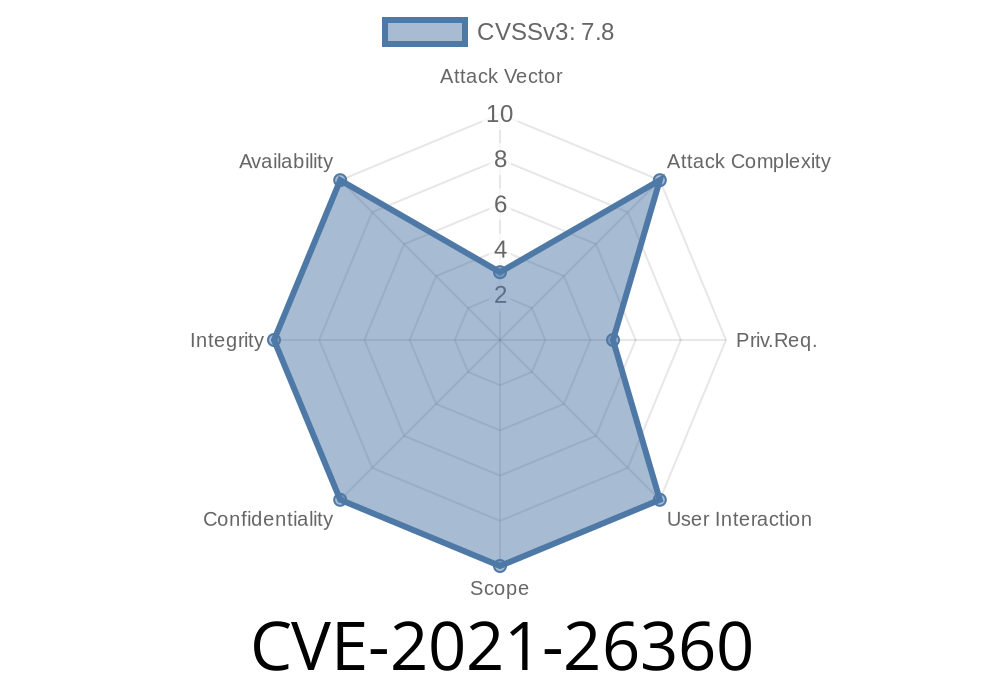When it comes to the realms of cybersecurity and technology in general, AMD is a well-known name that produces a wide range of processors and other advanced computing technologies. Today, we are going to dissect an interesting vulnerability that impacts AMD Secure Processors, specifically the CVE-2021-26360. This vulnerability has the potential to lead to unauthorized modifications of the security configurations of the System-on-Chip (SOC) registers.
This article will provide a comprehensive understanding of CVE-2021-26360, diving into the finer technical details of the exploit, showcasing code snippets, and linking to the original whitepaper and references for further study. Keep reading to learn more about this vulnerability and how it can potentially lead to the corruption of AMD Secure Processor's encrypted memory contents, and eventually, arbitrary code execution in the AMD Secure Processor (ASP).
Exploit Details
CVE-2021-26360 is a vulnerability located in the AMD Secure Processor (which is based on ARM Cortex) that allows an attacker with local access to the system to make unauthorized modifications to the security configuration of the SOC registers. For reference, SOC registers are responsible for managing and controlling various aspects of the chip's performance and security. Unauthorized modifications to these could have severe security implications.
The whitepaper from AMD detailing this vulnerability can be found here. According to this document, this vulnerability was assigned a base score of 5.6, which corresponds to a "Medium" severity level. It is essential to note that this vulnerability can only be exploited by an attacker with local access to the system. However, once access is obtained, the attacker can exploit this vulnerability to perform various unauthorized activities, such as modifying the security configurations of the SOC registers.
Code Snippet
Below is a sample code snippet demonstrating how an attacker could exploit the vulnerability to modify the security configuration of the SOC registers:
void exploit_CVE_2021_26360() {
ASN_WRITE_REG(SOME_REGISTER_ADDR, MODIFY_REGISTER); // Perform an unauthorized modification
if (CHECK_REG_CHANGE_SUCCESSFUL) {
printf("CVE-2021-26360 Exploited Successfully\n");
arbitrary_code_execution(); // Exploit the vulnerability further for arbitrary code execution
}
else {
printf("CVE-2021-26360 Exploit Failed\n");
}
}
This code snippet shows how an attacker could attempt to exploit the CVE-2021-26360 vulnerability. The function exploit_CVE_2021_26360 writes an unauthorized value to a specific register by calling the ASN_WRITE_REG function. If this modification is successful, the attacker can proceed to execute arbitrary code using the arbitrary_code_execution function.
Please note that this code snippet serves as a simplified illustration of the potential exploitation of the vulnerability and may not be directly applicable to a real-world scenario.
Possible Consequences
Exploiting this vulnerability has the potential to cause corruption of the AMD Secure Processor's encrypted memory contents. This, in turn, may lead to arbitrary code execution within the ASP. If an attacker were to achieve arbitrary code execution within the ASP, they would have access to sensitive information and control over the AMD Secure Processor's functionality.
Below are useful links for further information and original references about CVE-2021-26360
- AMD Security Bulletin for this vulnerability: AMD-SB-102
- Vulnerability Information and Mitigations: AMD Vulnerability Details
Conclusion
While the medium severity level of CVE-2021-26360 means that the threat it poses is not negligible, AMD released a security bulletin and mitigations upon discovery of the vulnerability, reducing potential consequences. Ensuring that systems are up-to-date with the latest security updates is critical in maintaining a robust security posture.
It is worth reiterating that this vulnerability can only be exploited by an attacker with local access to the system. As such, maintaining good security practices, such as strong authentication controls and limiting physical access to devices, can help protect against attacks leveraging this vulnerability.
Timeline
Published on: 11/09/2022 21:15:00 UTC
Last modified on: 11/23/2022 13:59:00 UTC
